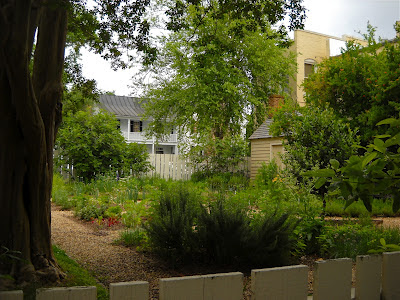Sometimes you just stumble across a beautiful garden. On a Monday morning in May, I made a detour while driving through North Carolina on US Highway 17. Edenton is home to the paternal grandmother in the novel I'm writing. In the past I had driven down the streets of Edenton in an effort to absorb the atmosphere, but I'd never gotten out and walked around. On that Monday last month I parked the car and set out on foot.
 |
| Edenton, North Carolina's Cupola House
Somehow I didn't notice the Cupola House - at least not immediately. It's located next to the library and as a lover of books and libraries I was drawn inside to browse the collection. But I didn't stay indoors long. Instead, I carried on walking around the block, admiring historic homes and the bits of garden that were visible from the street.
|
A gorgeous passionflower, of a different variety from those
I'd seen before, grew on the wall in front of one old house.
So many lovely remnants of the past and so many charming gardens. What must it be like to stroll along these streets every day?
 |
| Far right back: Pomegranate trees stretch skywards |
What I love most about gardens from the American colonial era is that they combined beauty with practicality. The pleasure garden and the kitchen garden each had their place and sometimes that place was side by side, sometimes intertwined.
A brochure available in the back garden of the Cupola House provides a partial plant list. The following is but a sample of what grows in these heritage gardens: plum, crabapple, fig, loquat, dogwood, a variety of roses, lemon balm, yellow flag iris, bluebell, foxglove, larkspur, hollyhock, garlic chives, thyme, tansy.
Yes, it was the pomegranate trees that first drew my attention to the Cupola House garden. What I didn't tell you is that in 2012 I'm having more success with my own pomegranate trees than I have in any year since I first planted them a decade ago. Three out of the four trees currently bear fruit. Seven pomegranates dangle from one tree, eleven from another, and sixteen from yet another. If all continues to go well, in the autumn I'll be spreading plenty of pomegranate love to friends and neighbors.












